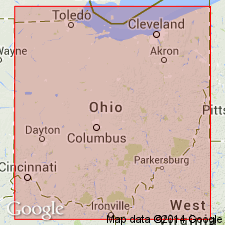
- Usage in publication:
-
- Lilley member
- Modifications:
-
- Named
- Dominant lithology:
-
- Limestone
- Clay
- AAPG geologic province:
-
- Cincinnati arch
Summary:
Lilley member named as upper unit of West Union formation at Hillsboro, Highland Co., OH. [West Union as here used extends up to base of Cedarville dolomite.] Unit consists of 2 or 3 ft of clay underlain by 20 ft of massive limestone. Exposed at various localities on Lilley Hill. Overlies Bisher member of West Union formation and immediately underlies Cedarville dolomite. Age is Silurian.
Source: GNU records (USGS DDS-6; Reston GNULEX).
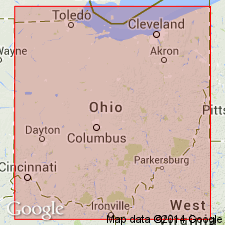
- Usage in publication:
-
- Lilley member
- Modifications:
-
- Overview
- AAPG geologic province:
-
- Cincinnati arch
Summary:
Lilley member of West Union formation is 20 to 30 ft thick. Overlies Bisher member of West Union, but at any distance from Hillsboro area it has proved so rarely possible to discriminate Bisher and Lilley members, if indeed the latter is present, that a collective term seems desirable. For this service West Union, used by Orton [but not in sense used by Orton], has been regarded as serviceable and as much more in keeping with exposures at West Union, OH, where no trace of Lilley member can be identified. It corresponds to Upper or Blue Cliff of Orton, who incorrectly identified it with Springfield dolomite. Is faunally distinct from Bisher member.
Source: GNU records (USGS DDS-6; Reston GNULEX).
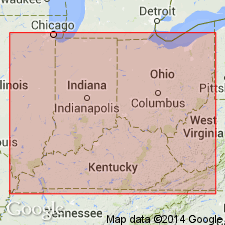
- Usage in publication:
-
- Lilley formation
- Modifications:
-
- Revised
- AAPG geologic province:
-
- Cincinnati arch
Summary:
Lilley formation of Hillsboro area, Highland Co., was erroneously identified many years ago by Prof. Orton as the Springfield stone. It is overlain by beds here tentatively called Guelph dolomite. The base of this so-called Guelph in quarries in eastern part of Hillsboro is formed by a PETAMERUS horizon, which corresponds approximately to Springfield dolomite of Green, Clarke, Miami, Montgomery, and Preble Cos. A fauna somewhat similar to underlying Bisher fauna is contained in beds immediately beneath Springfield limestone along creek 0.5 mi west of Port William, northeast of Wilmington OH, but no trace of Lilley fauna is to be found so far north.
Source: GNU records (USGS DDS-6; Reston GNULEX).
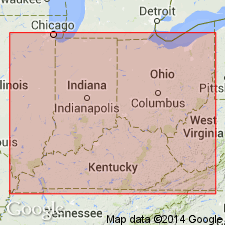
- Usage in publication:
-
- Lilley Formation
- Modifications:
-
- Overview
- AAPG geologic province:
-
- Cincinnati arch
Summary:
Unit now referred to as Lilley Formation was part of Cliff Limestone of Locke (1838) and was called Springfield stone by Orton (1871). Upper boundary of West Union Formation of Orton had not been precisely defined and when Foerste (1917) named the Lilley, he placed it in West Union as the upper member. Foerste (1923) then rejected name West Union and raised Lilley to formation rank. Consists of two main lithologies: gray to bluish-gray finely crystalline argillaceous dolomite having some shale partings, and fossiliferous and crinoidal light-gray medium- to coarse-grained dolomite. Average thickness 45 ft in southeastern Highland and Adams Cos. Maximum thickness 80 ft. Overlies Bisher Formation. Underlies Peebles Dolomite. Age is Silurian.
Source: GNU records (USGS DDS-6; Reston GNULEX).
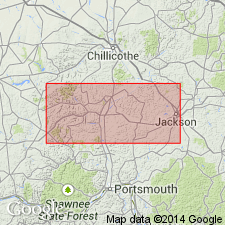
- Usage in publication:
-
- Lilley Formation
- Modifications:
-
- Biostratigraphic dating
- AAPG geologic province:
-
- Cincinnati arch
Summary:
Wenlockian age of the Lilley Formation is based on 10 species of conodont fauna. The Lilley Formation, Lilley-Peebles transition unit, and the Peebles Dolomite compose the upper Niagaran sequence along the east flank of the Cincinnati Arch in southern OH. The Lilley consists of two main lithologies: 1) gray to blue gray, fine-grained argillaceous, variably fossiliferous uneven- to thin-bedded dolomite with dolomitic shale partings and 2) light-gray, medium to coarse-grained fossiliferous dolomite. Thickness averages 15 m in Adams and southeastern Highland Cos. and thickens to 24 m in western and northwestern Highland Co. Eustatic sea-level fall in early to middle Wenlockian is proposed as the cause for shoaling during deposition. Underlies Peebles Dolomite and overlies Bisher Formation.
Source: GNU records (USGS DDS-6; Reston GNULEX).
For more information, please contact Nancy Stamm, Geologic Names Committee Secretary.
Asterisk (*) indicates published by U.S. Geological Survey authors.
"No current usage" (†) implies that a name has been abandoned or has fallen into disuse. Former usage and, if known, replacement name given in parentheses ( ).
Slash (/) indicates name conflicts with nomenclatural guidelines (CSN, 1933; ACSN, 1961, 1970; NACSN, 1983, 2005, 2021). May be explained within brackets ([ ]).

